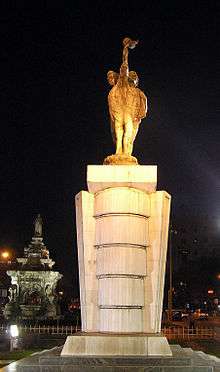Samyukta Maharashtra Samiti

Samyukta Maharashtra Movement (or Sanyukta Maharashtra Chalaval) was an organisation that, starting in 1956, demanded the creation of a separate Marathi-speaking state out of the (then-bilingual) State of Bombay in western India, with the city of Bombay as its capital.[1] Similarly, in 1956 the Mahagujarat Movement started agitation for creation of separate Gujarati-speaking State out of Bombay State, which became the state of Gujarat.
The Samyukta Maharashtra Movement achieved its aim when the present state of Maharashtra was created on 1 May 1960. The state reorganization left Marathi-speaking areas in Northern Karnataka, such as Belgaon, outside Maharashtra. The newly liberated people of Goa in a 1967 referendum rejected merger with Maharashtra.
History
The organisation was founded on 6 February 1956, under the leadership of Keshavrao Jedhe in Pune. Many of the Prominent activists of Samyukta Maharashtra Samiti were leftists such as Shreedhar Mahadev Joshi, Shripad Amrit Dange, Narayan Ganesh Gore, and Uddhavrao Patil. Other leaders included Maina Gawankar, Walchand Kothari, Pralhad Keshav Atre, Keshav Sitaram Thackeray, Pandurang Mahadev Bapat, Bhausaheb Raut, and Amar Shaikh. As a part of the campaign, P. K. Atre used his Maratha newspaper to criticise Prime minister Jawaharlal Nehru, Morarji Desai (then chief minister of Bombay state) and S.K. Patil, the Mumbai Congress party politician who favored separation of Mumbai city from a linguistically reconstituted Maharashtra or Gujarat[2]
The Indian National Congress had pledged to introduce linguistic states prior to Independence.[3] However, after Independence, Jawaharlal Nehru and Sardar Vallabhbhai Patel were adamantly opposed to linguistic states. They perceived linguistic states as a threat to the integrity of India. For the first time and perhaps the only time, Rashtriya Swayamsevak Sangh and its chief Madhav Sadashiv Golwalkar supported Nehru and Patel against redrawing of the map along linguistic lines. The catalyst to the creation of a States Re-organization Commission was the fasting death of Telugu nationalist Potti Sriramulu. In 1956, the SRC (States Re-organisation Committee) recommended creation of linguistic states of Andhra Pradesh, Kerala and Karnataka but recommended a bi-lingual state for Maharashtra-Gujarat, with Mumbai as its capital but vidarbha outside Maharashtra. Further, they recommended the creation of Vidharba state to unite the Marathi-speaking people of former Hyderabad state with Marathi-speaking areas of Central Provinces and Berar state. On 21 November 1955, demonstrators were fired upon by the police at Flora Fountain in the capital city of Mumbai. Flora Fountain was subsequently renamed Hutatma Chowk or "Martyr's Crossroad" in their memory. It is estimated that in all, 106 people were shot by security forces during the period of agitation and at different places. Morarji Desai, who was the then chief minister of Bombay state was later removed and replaced by Yashwantrao Chavan as a result of criticism related to the 21 November incident.[4] Nehru's speech dissenting with the SRC led C. D. Deshmukh, the then Finance Minister of the Nehru Cabinet to resign his post in January 1956.[3][5] This led to the creation of the predecessor movement Sanyukta Maharashtra Parishad, inaugurated on 1 November 1956, causing a great political stir and, under the leadership of Keshavrao Jedhe, a whole party meeting was held in Pune and Samyukta Maharashtra Samiti was founded on 6 February 1956. In the second general election of 1957, the Samiti defeated the stalwarts of Congress by securing 101 seats out of 133, including 12 from Mumbai. The Congress party could form a government only with the support of Gujarat, Marathwada and Vidharba.
The Samyukta Maharashtra Samiti achieved its goal on 1 May 1960, when the State of Bombay was partitioned into the Marathi-speaking State of Maharashtra and the Gujarati-speaking State of Gujarat. However Goa (then a Portuguese colony), Belgaum, Karwar and adjoining areas, which were also part of the Maharashtra envisaged by the Samiti, were not included in Maharashtra state. The prominent leaders of sanyukt maharashtra samiti decided to quit samiti after 1 May 1960, but the then chairman of the samiti Bhai Uddhavrao Patil continued his fight for the 862 Marathi-speaking villages of Karnataka that were excluded in 1960.
See also
References
- ↑ Dandavate, Madhu (19 November 2017). "Dialogue with Life". Allied Publishers. Retrieved 19 November 2017 – via Google Books.
- ↑ Guha, Ramachandra (2003-04-13). "The battle for Bombay". The Hindu. Retrieved 2008-11-12.
- 1 2 Windmiller, Marshall (1956). "The Politics of States Reorganization in India: The Case of Bombay". Far Eastern Survey. 25 (9 (Sep)): 129–143. doi:10.1525/as.1956.25.9.01p1062z. JSTOR 3024387.
- ↑ "BMC will give jobs to kin of Samyukta Maharashtra martyrs". epaper.TimesOfIndia.com. Retrieved 19 November 2017.
- ↑ Gopal, Sarvepalli (1980). Jawaharlal Nehru: A Biography, Volume 2: 1947-1956. Cambridge, MA, USA: Harvard University Press. ISBN 9781473521889. Retrieved 11 January 2017.
External links
- Samyukta Maharashtra movement
- Founding of the Samiti
- 'Zalach Pahije!' by P.K. Atre ISBN 81-86837-00-0